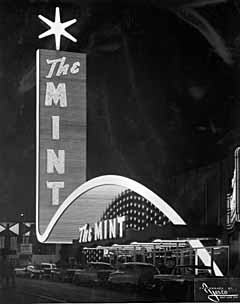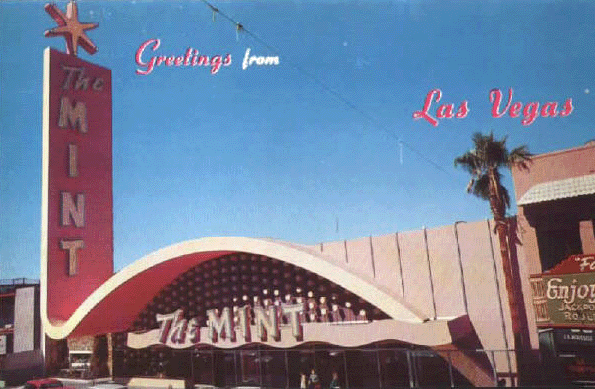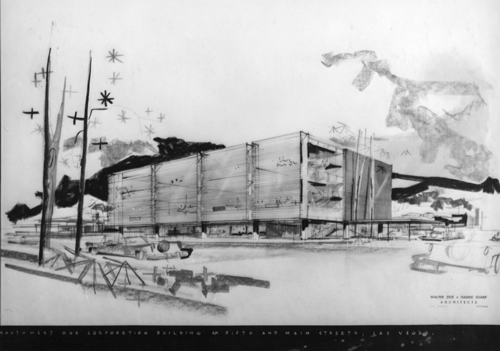
Want to know more fun historical facts and see historical images of many of the places on our "10 Fun Things to Do in Las Vegas" (as well as the history of the Strip and Neon Signs) then follow this link:
and purchase your autographed copy today!
Join us as we separate myth from fact, share stories of the men and women who helped build the town and celebrate one of the most fabulous cities ever built!

Want to know more fun historical facts and see historical images of many of the places on our "10 Fun Things to Do in Las Vegas" (as well as the history of the Strip and Neon Signs) then follow this link:
and purchase your autographed copy today!
For information on our upcoming Mid-Century Modern Salute to Walter Zick, click here
I'm tired of reading articles in papers like the Los Angeles Times (a paper that I used to love and is now barely on life-support) about all the things to do in Las Vegas. Why? Because they all revolve around gambling and shows.
Las Vegas is much more than just gambling, drinking and going to shows. There is a whole side of the town that visitors and even locals rarely take the time to see.
So, we thought we'd list ten of our favorite things to do in and around Las Vegas that DON'T involve gambling or taking in a show. Drinking afterwards is optional. Just don't drive.

10. Visit Boulder City. The Best Dam town likes to bill itself as "A World Away in a Day". Visiting Boulder City is like walking back in time. There are no casinos and they are very stringent about building heights and growth. Much of Boulder City looks like it did in the 1940s and the 1950s.
Stop in at Milo's for sandwiches, cheese platters, dessert and some of the best wines (reasonably priced) in the Valley. Since Dennis moved into town we don't haunt Milo's the way we used to but you have no excuse.
Go, walk around, visit the antique shops, the galleries, the Boulder Dam Hotel and Museum (call ahead and make sure the Museum is open) and finish off your day with bite to eat at Milo's. Enjoy the patio dining and the people watching. It's worth the trip. Check and see if there are any events at the Boulder Theater (the fall Chatauqua might be coming).

9. Visit the Valley of Fire. Everyone always talks about Red Rock Canyon on the other side of the Valley. But this is one of the most amazing places in the Southwest. Wonderful red rock formations, lots of history and landscape just made for taking pictures. It's a State Park located not very far from Boulder City and on the way to Lake Mead. It is Nevada's oldest and largest State Park, having been dedicated in 1935. Ancient trees and early man are represented throughout the park by areas of petrified wood and 3,000 year-old Indian petroglyph. Popular activities include camping, hiking, picnicking and photography. The park offers a full-scale visitor center with extensive interpretive displays. Several group use areas are also available. The park is open all year. Take plenty of drinking water and wear shoes made for hiking.

8. Visit St. Thomas. This Mormon farming community was a thriving little town until the construction of the Dam heralded it's demise. The town was evacuated in the mid-1930s and the rising waters of Lake Mead submerged homes, civic buildings and the like. The water in Lake Mead has shrunk so low that for the past few years the ruins of St. Thomas have been rising up. Well, they are all on view now. The Park Service has trails that lead down to the various ruins. Take plenty of drinking water and wear hiking shoes. It's a great way to spend a half a day examining the ruins. On the way back, stop in Overton and take in the Lost City Museum.

7. Visit the Techatticup Mine. Down in Nelson, you can tour one of the most famous mines in Southern Nevada, the Techatticup.It's the oldest, richest and most famous gold mine in Southern Nevada. Located just 45 minutes outside of Las Vegas, they provide historical mining tours and scenic blue water cove trips on the Colorado River at the mouth of Black Canyon below Hoover Dam. You will visit historical sites where steamboats docked and stamp mills operated over 100 years ago. Stop in at the small museum and soak up history. Take plenty of drinking water and wear hiking shoes!

6. Check out the wonderful Roadside Motels on East Fremont Street. It may not look like the best neighborhood but it is filled with lots of history. This is one of the largest collections of roadside motels from the 1940s and 1950s still standing. From the Pair-a-Dice and the Blue Angel just past the turn from Boulder Highway all the way up to where the Ambassador East used to stand, you'll get an idea of what travelers to Las Vegas saw when they first arrived from Arizona and Utah. Back in the day, this was the gateway to Fremont Street for many weary travelers.

5. Visit the Nevada State Museum in Lorenzi Park. Lorenzi Park has plenty of history all on its own but the State Museum being there is an extra bonus. Due to state budget cuts, the Museum is only open from Wednesdays through Saturdays, 9:00 - 5:00 pm, but they have exhibits on the wildlife of Nevada, the history of Las Vegas (including the early days), a bat exhibit and a revolving exhibit. Plus, the library has plenty of newspapers on microfiche for easy browsing. The staff is great and eager to help.

4. Visit the Las Vegas High School Historic Neighborhood. Las Vegas High School, now the Performing Arts Academy, is the oldest high school in Las Vegas. Built in the 1930s, it was the first high school built. Located on 8th Street, just south of Fremont Street, it still stands as a testiment to the hardy families who helped Las Vegas grow. Be sure to check out the Senior Squares on the front steps. Though the neighborhood is on the Historic Register, many of the houses which were lived in by those pioneering families are being torn down and McOffices are taking their place. But you can still get a very good idea of the bucolic neighborhood it once was with it's charming architecture and manicured lawns. Walking tour maps are available from the City website. When finished, drive over to the Fifth Street School at Las Vegas Blvd South and Lewis, and tour the restored building of what was once our main grammar school.

3. Visit the other historic neighborhoods around Las Vegas. As Las Vegas began to grow, the city started spreading out. Historic neighborhoods such as Huntridge, Marycrest, Alta, Bonanza Village, Beverly Green, Paradise Palms and John S. Parks all offer glimpes into the growth from a dusty railroad town to the Entertainment Capital of the World.

2. Walk Fremont Street. Forget the gambling and the girlie places. Fremont Street is the oldest street in Las Vegas. Read our Brief History (click on the link above) to get started. From Main to 6th Street, if you look close enough you can still find glimpses of its historic past peeking out in the darndest places. So, take a walk down to the El Cortez and back and pay attention to the buildings. You'll be surprised at what you find. Afterwards, go to Dona Maria's for some of the best and most reasonably priced Mexican food in Very Vintage Vegas!

1. Start attending our monthly series, Untold Stories at the Springs Preserve. We are beginning our third season at the Springs Preserve next week. This is the only series that each month brings long-time residents out to talk about the history they made and that they witnessed. Want to know more about the history of Las Vegas? Then join us the first Thursday of every month (dark in January) and hear how history was made here from the people who lived it. Upcoming topics include Mining in Southern Nevada, the History of the Moulin Rouge, Howard Hughes and Las Vegas and Las Vegas History You Don't Know.
First Thursday of Every Month at the Springs Preserve. 6:30 pm. Come early and check out the museums, the hiking trails and the view. The Springs is where Las Vegas began. Without it's flowing water, no one would remember Las Vegas today. So, come immerse yourself in history. It won't hurt and you'll be surprised at how much you learn and how enjoyable history can be to learn!



If all Walter Zick and partner Harris Sharpe ever designed was the Mint Hotel and it's beautiful neon sign that would be enough.
But Walter Zick designed much more than just the most beloved, lost neon sign of Las Vegas. He designed a variety of commercial buildings, mainly banks, schools and residential homes.
A lot of his architecture is still standing which is really amazing considering the reputation Las Vegas has with preserving history.
As noted here earlier this year, we became much more aware of Walter Zick's architectural contribution to the Las Vegas Valley when we got a disc from Jack LeVine over at VeryVintageVegas that had been put together by Zick's daughters in hopes of having a school in the Valley named after their father.
While the School District turned down the daughters, we came up with an idea and working with the Nevada State Museum, Las Vegas and Nevada Humanities, we received a grant to do a program centered around Walter Zick and his mid-century architecture.
On October 3rd we will have a panel discussion at the State Museum on the work of Walter Zick. Confirmed panelists include our favorite mid-century author and historian, Alan Hess, Assemblage Studios' architect, Eric Strain, Karen Zick Goff and her sister, Claire and neon designer, Brian "Buzz" Leming.
Following the discussion, there will be an afternoon bus tour of some of Zick's still-standing architecture. The final stop on the tour will be the Morelli House. Though Zick did not design the Morelli House, it's mid-century architecture makes it a perfect place to have a small reception before returning to the State Museum.
We are currently working out the bus route, which we hope will include a few stops so that we can see the interiors of some of the buildings. Once we have all the details worked out, we will post them here.
Seating for the bus tour is limited and reservations will be necessary. Once we have the reservation number working, we will post that as well.
So, subscribe to this blog because you are not going to want to miss this. If you ever wondered what happened to mid-century modern Las Vegas or how it came to be, this is the program for you. If, like me, you've always appreciated how modern our Valley truly was, you won't want to miss this program.
It's going to be historic, fact-filled and lots of fun.
So, stay tuned.

This program made possible by Nevada Humanities and the Nevada State Museum and the generous donations of VeryVintageVegas, the Friends of Classic Las Vegas, Brian "Paco" Alvarez and the Junior League of Las Vegas.
It doesn't look like it now, though the bones are all still there if you look close enough, but when I was a kid growing up in Las Vegas, McCarran Airport was a mid-century modern oasis.
The new terminal was designed by Los Angeles architect, Welton Beckett and it fit right in with the space age theme that was prevalant back then. From the Landmark tower to the Convention Center, the new terminal would be right at home.
The Nevada State Museum, Las Vegas has a wonderful collection of photographs and negatives from one of the busiest and best photographers of that era, Jay Florian Mitchell. Mitchell came to Las Vegas in the early 1950s and began photographing the town. You can chart the transformation of Las Vegas from a town into a growing city by looking at the photos and negatives that are in this collection. Mitchell's work spans the mid-1950s to the late 1970s and includes aerials.
Here are some of McCarran Airport:





